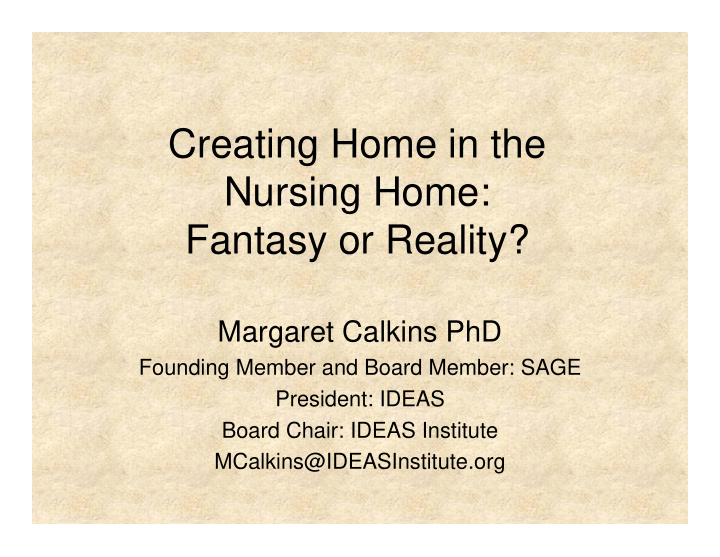



Creating Home in the Nursing Home: Fantasy or Reality? Margaret Calkins PhD Founding Member and Board Member: SAGE President: IDEAS Board Chair: IDEAS Institute MCalkins@IDEASInstitute.org
Mid pleasures and palaces, though we may roam, Be it ever so humble there’s no place like home J Payne
Language is Important • Person Centered Care • Resident-Directed Care • Self-Directed Care
Layers of the Meaning of Home • Psychological State • Expression of Self • Design Typology
Home as Psychological State • Safe and secure • In control of our actions and environment • In relationship with people we choose
In a (traditional) Nursing Home… • Staff have virtually all the control – Timing of almost everything – wake up, meals, shower/bath, activities, trips, going outside. – What is served at meals- often a 4-6 week rotation of the same foods over and over again – sometimes as short as 3 weeks. – What activities people engage in. – When people can go outside.
What Decisions CAN Residents Control? • When to get up • What to have for breakfast • When and where to bathe • What to do each day In Short- EVERYTHING!
Home as Expression of Self Tag 252: “the facility must provide a safe, clean, comfortable and homelike environment, allowing the resident to use his or her personal belongings to the extent possible.”
The interpretative guidelines define a homelike environment as “one that de- emphasizes the institutional character of the environment as much as possible and allows residents to use those personal belongings that reflect a homelike environment. A personalized homelike environment is one that recognizes the individuality individuality and autonomy of the resident, autonomy opportunity for self- provides an opportunity for self- expressions expressions and encourages links with the encourages links with the past and family members.” past and family members.”
Most of the rest of the interpretative guideline focuses on personal belongings in the residents’ bedrooms and when their absence should be questioned. While this is important, it does not address either residents belongings in the shared areas of the household, nor de-institutionalization of other elements in the setting. “HOME-LIKE” is more than a few knick-knacks in your bedroom
Meadows Trillium Place
Home as Design Typology
#3: Build houses, not institutions
Other Recommendations
Eliminate Institutional Icons Not in Federal Regulations, but state regulations vary tremendously . Affectionately referred to as the world’s largest nursing home Wesley Home
Creekview at Evergreen
Other Institutional Icons • Overhead Paging • Voice-voice communication • Call bells/lights • Call lights in sconces • Monotony of furniture • Indirect lighting • 2x4 fluorescent lights • Carpeting • Shiny floors • Staff in street clothes • Staff uniforms
Focus on Care , not Documentation
Encourage Efficient Technologies
Passive Monitoring Bed exit sensor Incontinence sensor Motion sensors Bed sensor outlet Motion sensors Staff cancel switch
Make Self-Directed Care a Core Value • Include in training for all staff • Incorporate into job descriptions • Base evaluations on supporting self- directed care
Increase Basic Training Requirements • It is a travesty that training requirements to be a nursing assistant may be as low as 40 hours, half of which is classroom and half is following someone on the floor. • Manicurists are required to have 400 hours of training before they are certified.
Training from the Top Owners, Administrators, Board Members should be required to work 1 day every month or 2 as a caregiver. This is the only way to really know what is going on.
Control, Control, Control • Who you share a room with • More options of food choice, style, location, companion • Bringing personal belongings for the bedrooms and beyond • Hiring of staff
Recommend
More recommend